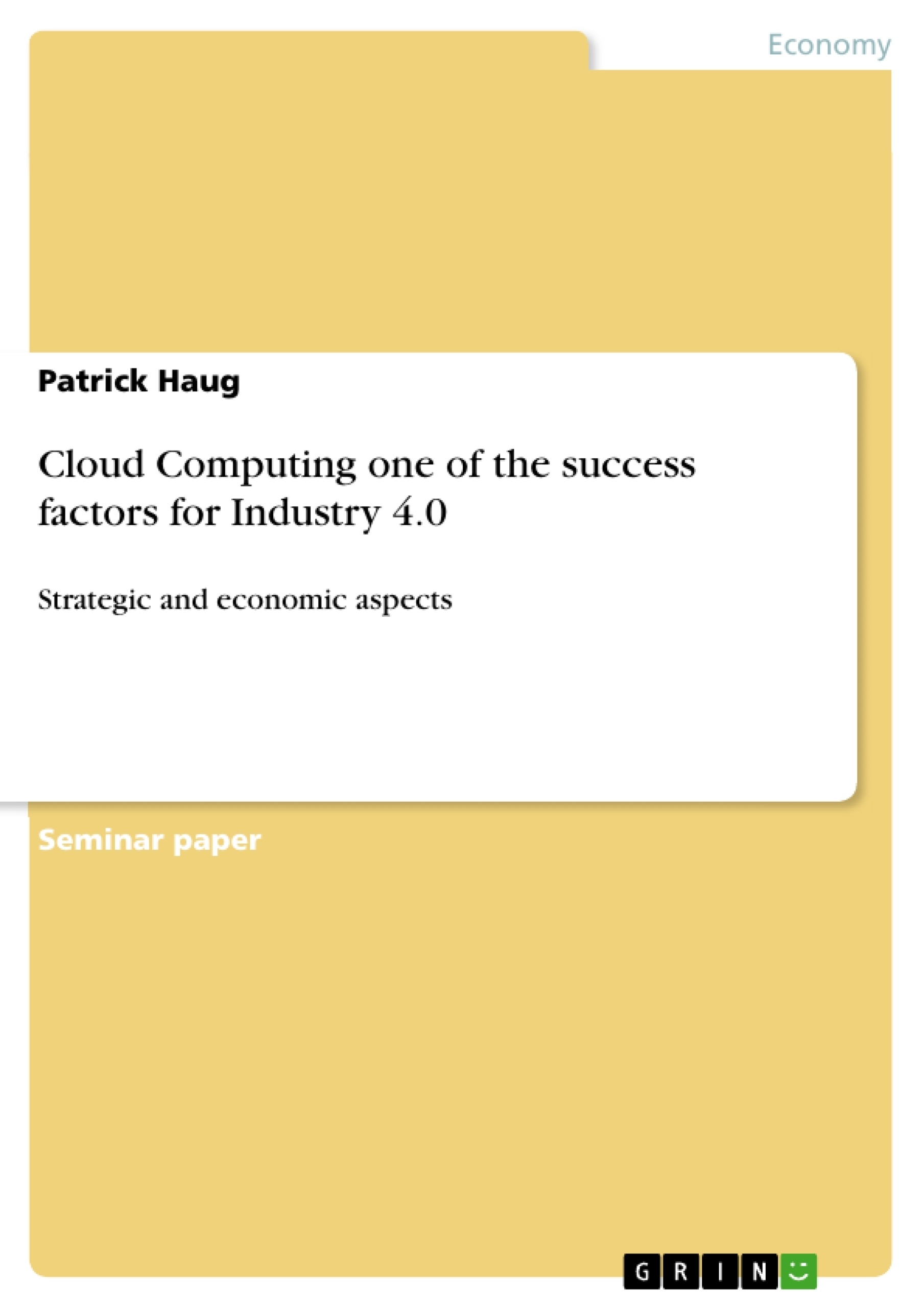The aim of this term paper is to outline the opportunities and risks connected with the introduction of cloud systems. In addition to the strategic aspect the term paper will evaluate the economic aspect of cloud strategies by examining how to adapt the Total Cost of Ownership (TCO) method to suit cloud services.
The first chapters of this paper will present the underlying relationships between Industry 4.0, Internet of Things (IoT), Smart Production and the underlying technology stack behind, followed by an overview of the cloud solutions available as of today. This paper then evaluates the strategic potential of cloud strategies before finally providing a valuation model to deal with the challenge of ascertaining the economic potential of cloud solutions.
The first objective of the term paper work is to evaluate the potential of a cloud strategy based on SWOT analysis. The second key question is how to adapt and extend information technology typical commercial valuation models to a cloud strategy based business case.
Inhaltsverzeichnis (Table of Contents)
- Introduction
- Drivers of Industry 4.0
- Internet of Things
- Aspects of Industry 4.0
- Technology Stack
- Cloud Computing
- Cloud Levers
- Outsourcing of Cloud - Typical Pay System
- SWOT: Cloud and Industry 4.0
- Strengths
- Weaknesses
- Opportunities
- Threats
- Service Capacity of Industry 4.0
- Economic Aspects of Classic IT
- Profitability Analysis - Classic Methods
- Basic - Static method - Rol
- Basic Dynamic method - NPV
- IT cost-based profitability analysis on TCO
- Profitability Analysis - Classic Methods
- Strategic Potentials of Cloud Systems
- Conclusion of adaption fields of action
- Speed
- Capex vs. Opex
- Optimization of Total Costs
- Scalability and flexibility
- Profit maximization
- Meeting regulations and guidelines
- Adaptation of the direct and indirect costs of TCO
- Adaptation of the direct costs of TCO
- Adaptation of the indirect costs of TCO
- Cloud-related adjustments of the TCO model
Zielsetzung und Themenschwerpunkte (Objectives and Key Themes)
This term paper explores the opportunities and risks associated with integrating cloud systems in the context of Industry 4.0. It examines both the strategic and economic aspects of cloud strategies. The paper aims to provide a framework for understanding how to adapt traditional Total Cost of Ownership (TCO) models to suit cloud services.
- The relationship between Industry 4.0, Internet of Things (IoT), and Smart Production.
- The role of cloud computing in supporting the architectural requirements of smart factories.
- A SWOT analysis of cloud strategies for Industry 4.0.
- The adaptation of traditional IT valuation models to cloud-based business cases.
- The economic potential of cloud solutions through TCO analysis.
Zusammenfassung der Kapitel (Chapter Summaries)
- Introduction: This chapter provides an overview of the evolution of industrial revolutions, highlighting the impact of technological advancements on global gross domestic product (GDP). It introduces the concept of Industry 4.0 and its foundation in Cyber Physical Systems (CPS).
- Drivers of Industry 4.0: This chapter delves into the key drivers of Industry 4.0, including the Internet of Things (IoT), aspects of Industry 4.0, the underlying technology stack, and the role of cloud computing. It also examines the advantages and drawbacks of utilizing cloud services, including typical payment systems and the outsourcing of cloud services.
- SWOT: Cloud and Industry 4.0: This chapter presents a comprehensive SWOT analysis, examining the strengths, weaknesses, opportunities, and threats associated with integrating cloud computing into Industry 4.0. It concludes with a discussion on the service capacity of Industry 4.0 based on a survey of small and medium-sized enterprises.
- Economic Aspects of Classic IT: This chapter explores traditional economic methodologies used in information technology. It delves into classic profitability analysis methods, including static and dynamic approaches, and examines IT cost-based profitability analysis through the Total Cost of Ownership (TCO) model.
- Strategic Potentials of Cloud Systems: This chapter focuses on the strategic advantages of utilizing cloud systems. It examines how cloud computing can accelerate processes, optimize total costs, and enhance scalability and flexibility. It also discusses the role of cloud computing in profit maximization and compliance with regulations.
- Conclusion of adaption fields of action: This chapter summarizes the key adaption fields of action related to cloud strategy implementation. It focuses on aspects such as optimizing total costs, enhancing scalability and flexibility, meeting regulations, and adapting direct and indirect costs within the TCO model.
Schlüsselwörter (Keywords)
This paper focuses on the key concepts of Industry 4.0, cloud computing, strategic analysis, economic evaluation, and the Total Cost of Ownership (TCO) model. It also explores the relationship between these concepts and the Internet of Things (IoT), Cyber Physical Systems (CPS), and smart factories. The paper delves into the economic aspects of cloud strategies, examining profitability analysis methods and the adaptability of traditional IT valuation models to a cloud-based business case.
- Quote paper
- Patrick Haug (Author), 2016, Cloud Computing one of the success factors for Industry 4.0, Munich, GRIN Verlag, https://www.grin.com/document/385753



